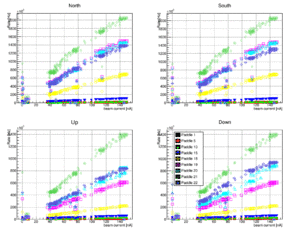Difference between revisions of "High Intensity Running"
From GlueXWiki
(→Planning) |
(→TOF) |
||
| Line 12: | Line 12: | ||
=== TOF === | === TOF === | ||
| − | rates for PMTs of selected paddles | + | rates for PMTs of selected paddles, paddle 1 to 19 are regular width/length paddles, paddle 20 and 21 are narrow width long paddles and paddle 22 is a short single ended paddle. The rates are in Hz as a function of beam current in nA. The data are from runs 11634 to 11637 where luminosity scans were done from 40 to 140nA<br>[[File:TOF_PMT_rates.gif|300px]] |
=== Near-term Questions === | === Near-term Questions === | ||
Revision as of 11:04, 9 August 2016
Overview
This page gathers information related to high intensity (5 x 107 γ/s - 50 MHz in 8.4-9.0 GeV) GlueX running.
Reference Material
- L3 min-review Slides (7/22/2016 )
- Level-3 Trigger Meetings
- Constraints from VME and Network Interfaces
- Flux: evaluation of the photon flux for Spring 2016 - 10Mhz (8.4-9.0 GeV) with the old "50 µm" diamond, PERP mode, 5mm collimator, beam 130µA
Planning
TOF
rates for PMTs of selected paddles, paddle 1 to 19 are regular width/length paddles, paddle 20 and 21 are narrow width long paddles and paddle 22 is a short single ended paddle. The rates are in Hz as a function of beam current in nA. The data are from runs 11634 to 11637 where luminosity scans were done from 40 to 140nA
Near-term Questions
Here is a place to gather some questions that need to be answered in order to properly plan for high intensity running.
- L1 trigger
- What is a reasonable ratio of various trigger types at high intensity?
- What is the L1 trigger rate expected for the 50 MHz beam, extrapolating the Spring 2016 conditions: the FCAL+BCAL trigger? other triggers? The accidentals should be considered.
- What is the relative drop of the trigger efficiency for a twice more stringent FCAL+BCAL trigger, which would leave 50% of the events of the 2016 Spring run?
- Would a ST*(FCAL+BCAL), or other coincidence help to reduce the trigger rate minimizing the efficiency loss?
- DAQ
- How do the event sizes scale with the beam intensity (for the triggers used)?
- What are the expected data rates for each crate?
- How do the data rates scale with beam intensity?
- Can we reduce the data read from each crate by dropping headers or reformatting? (e.g. fADC125 Trigger Times)
- Can we reduce the data read from each crate by reducing readout windows?
- Do the tagger data rates really drop below the FDC when the windows are reduced?
- What is the real limit on the VME data transfer speed considering the bus clocks and the duty cycles provided by various modules?
- What crates (FDC?) would limit the DAQ capabilities at the VME transfer level?
- What crates would limit the DAQ capabilities at the Ethernet level? What gain a 10 Gb interface would provide?
- L3
- What would be the largest reduction factor at "high intensity" (long events), if no time limit is considered?
- How many nodes are needed for a reduction factors of 4 at a 100 kHz event rate?